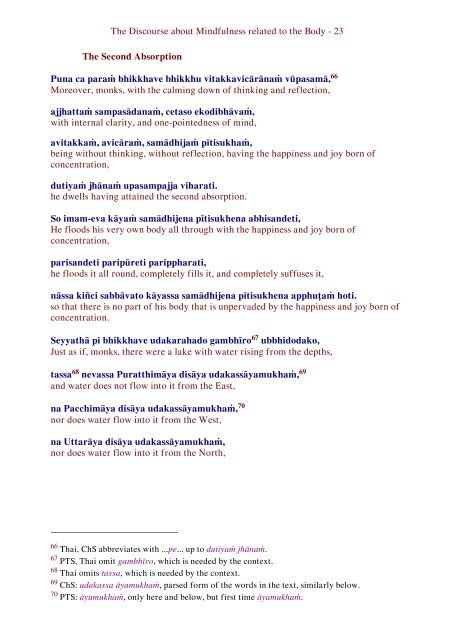Kayagatasatisuttam, the Discourse about Mindfulness related to the Body
A Pāli and English line by line (interlinear) version of this important discourse about the development of various meditations related to the body (together with extensive annotation).
A Pāli and English line by line (interlinear) version of this important discourse about the development of various meditations related to the body (together with extensive annotation).
You also want an ePaper? Increase the reach of your titles
YUMPU automatically turns print PDFs into web optimized ePapers that Google loves.
The <strong>Discourse</strong> <strong>about</strong> <strong>Mindfulness</strong> <strong>related</strong> <strong>to</strong> <strong>the</strong> <strong>Body</strong> - 23<br />
The Second Absorption<br />
Puna ca paraṁ bhikkhave bhikkhu vitakkavicārānaṁ vūpasamā, 66<br />
Moreover, monks, with <strong>the</strong> calming down of thinking and reflection,<br />
ajjhattaṁ sampasādanaṁ, cetaso ekodibhāvaṁ,<br />
with internal clarity, and one-pointedness of mind,<br />
avitakkaṁ, avicāraṁ, samādhijaṁ pītisukhaṁ,<br />
being without thinking, without reflection, having <strong>the</strong> happiness and joy born of<br />
concentration,<br />
dutiyaṁ jhānaṁ upasampajja viharati.<br />
he dwells having attained <strong>the</strong> second absorption.<br />
So imam-eva kāyaṁ samādhijena pītisukhena abhisandeti,<br />
He floods his very own body all through with <strong>the</strong> happiness and joy born of<br />
concentration,<br />
parisandeti paripūreti parippharati,<br />
he floods it all round, completely fills it, and completely suffuses it,<br />
nāssa kiñci sabbāva<strong>to</strong> kāyassa samādhijena pītisukhena apphuṭaṁ hoti.<br />
so that <strong>the</strong>re is no part of his body that is unpervaded by <strong>the</strong> happiness and joy born of<br />
concentration.<br />
Seyyathā pi bhikkhave udakarahado gambhīro 67 ubbhidodako,<br />
Just as if, monks, <strong>the</strong>re were a lake with water rising from <strong>the</strong> depths,<br />
tassa 68 nevassa Puratthimāya disāya udakassāyamukhaṁ, 69<br />
and water does not flow in<strong>to</strong> it from <strong>the</strong> East,<br />
na Pacchimāya disāya udakassāyamukhaṁ, 70<br />
nor does water flow in<strong>to</strong> it from <strong>the</strong> West,<br />
na Uttarāya disāya udakassāyamukhaṁ,<br />
nor does water flow in<strong>to</strong> it from <strong>the</strong> North,<br />
66 Thai, ChS abbreviates with ...pe... up <strong>to</strong> dutiyaṁ jhānaṁ.<br />
67 PTS, Thai omit gambhīro, which is needed by <strong>the</strong> context.<br />
68 Thai omits tassa, which is needed by <strong>the</strong> context.<br />
69 ChS: udakassa āyamukhaṁ, parsed form of <strong>the</strong> words in <strong>the</strong> text, similarly below.<br />
70 PTS: āyumukhaṁ, only here and below, but first time āyamukhaṁ.

















